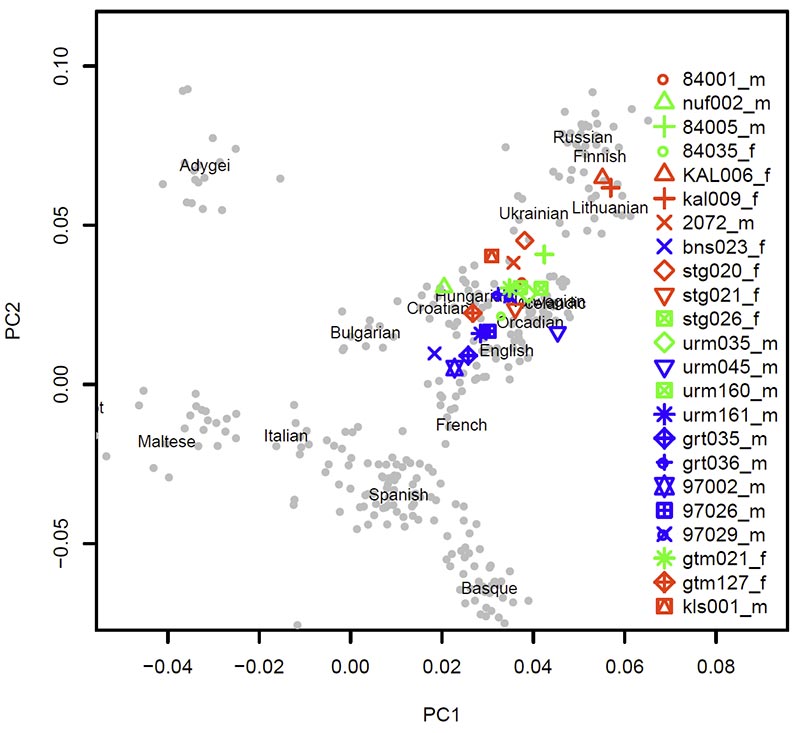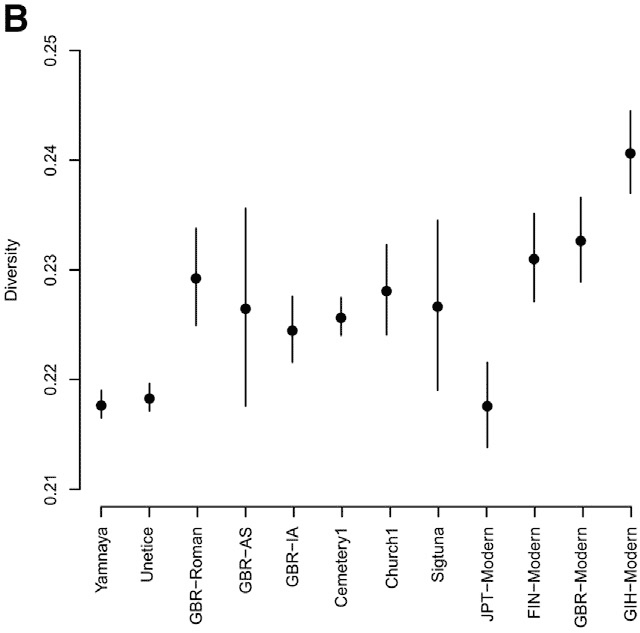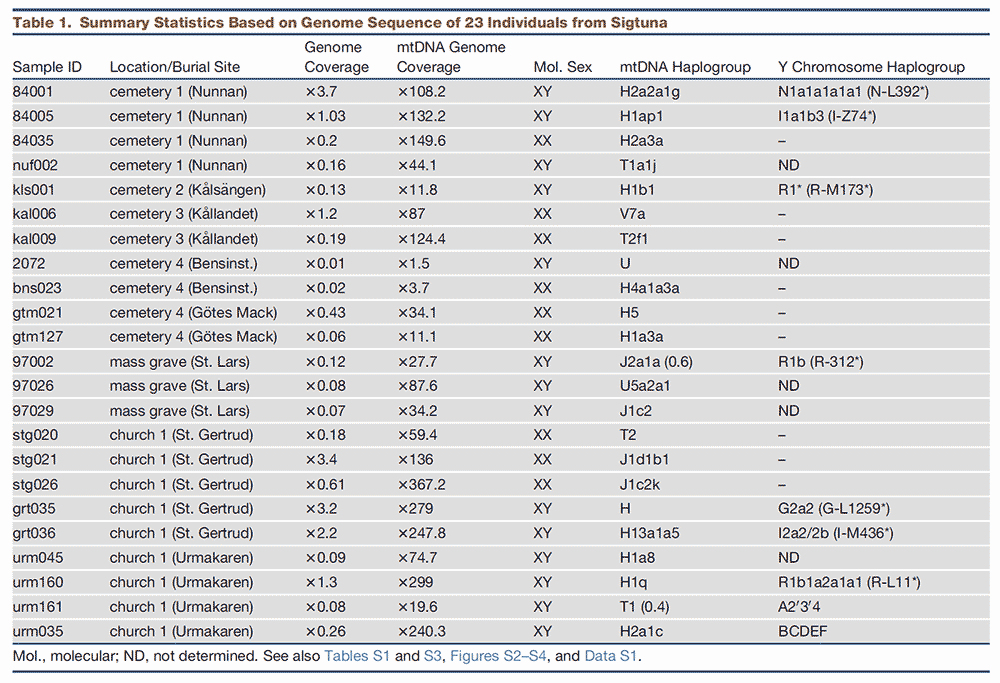Open access Genomic and Strontium Isotope Variation Reveal Immigration Patterns in a Viking Age Town, by Krzewińska et al., Current Biology (2018).
Interesting excerpts (emphasis mine, some references deleted for clarity):
The town of Sigtuna in eastern central Sweden was one of the pioneer urban hubs in the vast and complex communicative network of the Viking world. The town that is thought to have been royally founded was planned and organized as a formal administrative center and was an important focal point for the establishment of Christianity [19]. The material culture in Sigtuna indicates that the town had intense international contacts and hosted several cemeteries with a Christian character. Some of them may have been used by kin-based groups or by people sharing the same sociocultural background. In order to explore the character and magnitude of mobility and migration in a late Viking Age town, we generated and analyzed genomic (n = 23) and strontium isotope (n = 31) data from individuals excavated in Sigtuna.
The mitochondrial genomes were sequenced at 1.5× to 367× coverage. Most of the individuals were assigned to haplogroups commonly found in current-day Europeans, such as H, J, and U [14, 26, 27]. All of these haplotypes are present in Scandinavia today.
The Y chromosome haplogroups were assigned in seven males. The Y haplogroups include I1a, I2a, N1a, G2a, and R1b. Two identified lineages (I2a and N1a) have not been found in modern-day Sweden or Norway [28, 29]. Haplogroups I and N are associated with eastern and central Europe, as well as Finno-Ugric groups [30]. Interestingly, I2a was previously identified in a middle Neolithic Swedish hunter-gatherer dating to ca. 3,000 years BCE [31].
In Sigtuna, the genetic diversity in the late Viking Age was greater than the genetic diversity in late Neolithic and Bronze Age cultures (Unetice and Yamnaya as examples) and modern East Asians; it was on par with Roman soldiers in England but lower than in modern-day European groups (GBR and FIN; Figure 2B). Within the town, the group excavated at church 1 has somewhat greater diversity than that at cemetery 1. Interestingly, the diversity at church 1 is nearly as high as that observed in Roman soldiers in England, which is remarkable, since the latter was considered to be an exceptionally heterogeneous group in contemporary Europe [39].

Different sex-related mobility patterns for Sigtuna inhabitants have been suggested based on material culture, especially ceramics. Building on design and clay analyses, some female potters in Sigtuna are thought to have grown up in Novgorod in Rus’ [40]. Moreover, historical sources mention female mobility in connection to marriage, especially among the elite from Rus’ and West Slavonic regions [41, 42]. Male mobility is also known from historical sources, often in connection to clergymen moving to the town [43].
Interestingly, we found a number of individuals from Sigtuna to be genetically similar to the modern-day human variation of eastern Europeans, and most harbor close genetic affinities to Lithuanians (Figure 2A). The strontium isotope ratios in 28 adult individuals with assigned biological sex and strontium values obtained from teeth (23 M1 and five M2) show that 70% of the females and 44% of the males from Sigtuna were non-locals (STAR Methods). The difference in migrant ratios between females and male mobility patterns was not statistically significant (Fisher’s exact test, p = 0.254 for 28 individuals and p = 0.376 for 16 individuals). Hence, no evidence of a sex-specific mobility pattern was found.
(…) As these social groups are not mirrored by our genetic or strontium data, this suggests that the inclusion in them was not based on kinship. Therefore, it appears as if socio-cultural factors, not biological bonds, governed where people were interred (i.e., the choice of cemetery).

Interesting from this paper is the higher genetic (especially Y-DNA) diversity found in more recent periods (see e.g. here) compared to Neolithic and Bronze Age cultures, which is probably the reason behind some obviously wrong interpretations, e.g. regarding links between Yamna and Corded Ware populations.
The sample 84001, a “first-generation short-distance migrant” of haplogroup N1c-L392 (N1a in the new nomenclature) brings yet more proof of how:
- Admixture changes completely within a certain number of generations. In this case, the N1c-L392 sample clusters within the genetic variation of modern Norwegians, near to the Skane Iron Age sample, and not with its eastern origin (likely many generations before).
- This haplogroup appeared quite late in Fennoscandia but still managed to integrate and expand into different ethnolinguistic groups; in this case, this individual was probably a Viking of Nordic language, given its genetic admixture and its non-local (but neighbouring Scandinavian) strontium values.
Related
- Reproductive success among ancient Icelanders stratified by ancestry
- On Latin, Turkic, and Celtic – likely stories of mixed societies and little genetic impact
- Genomic analysis of Germanic tribes from Bavaria show North-Central European ancestry
- Germanic tribes during the Barbarian migrations show mainly R1b, also I lineages
- mtDNA suggest original East Germanic population linked to Jutland Iron Age and Bell Beaker
- Admixture of Srubna and Huns in Hungarian conquerors
- The concept of “Outlier” in Human Ancestry (III): Late Neolithic samples from the Baltic region and origins of the Corded Ware culture
- Genetic prehistory of the Baltic Sea region and Y-DNA: Corded Ware and R1a-Z645, Bronze Age and N1c
- Bell Beaker/early Late Neolithic (NOT Corded Ware/Battle Axe) identified as forming the Pre-Germanic community in Scandinavia
- The Tollense Valley battlefield: the North European ‘Trojan war’ that hints to western Balto-Slavic origins
